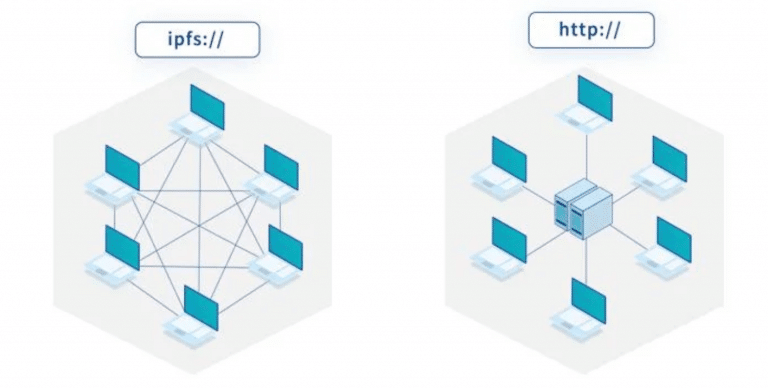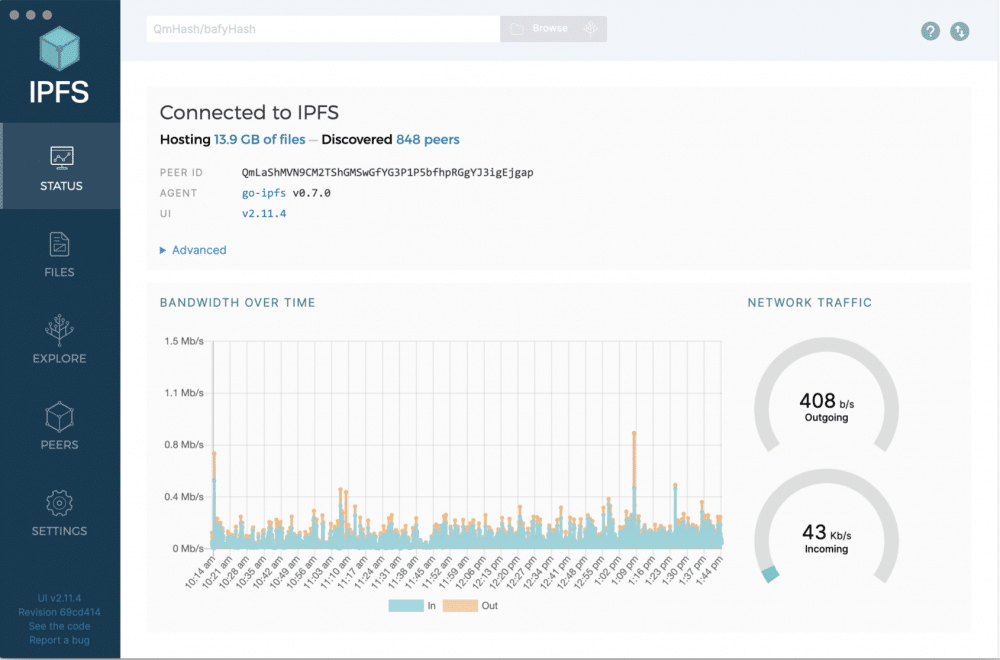The InterPlanetary File System (IPFS) is a Web 3.0 peer-to-peer protocol that aims to fundamentally transform the way digital files are distributed around the world. Based on decentralisation, IPFS leverages its collaborative network to offer an alternative to traditional Web 2.0.
What is IPFS?
To explain what the InterPlanetary File System (IPFS) protocol is, we need to go back in time to first understand why it was created.
In 1991, Tim Berners-Lee invented the HyperTest Transfer Protocol (HTTP), the beginning of the World Wide Web as we know it. We are all familiar with HTTP, as we use it every day when surfing the Web. Over time, there has been criticism of HTTP, particularly the massive centralisation of data in data centres, which must run 24 hours a day.
This puts a heavy load on servers, leaving them vulnerable to crashes or even to denial-of-service attacks (known as DDOS). The consequences can be disastrous: data theft, leakage or even outright loss of data. The costs of preventing such attacks are increasing over time.
Twenty-three years later, in 2014, Juan Benet, CEO of Protocol Labs, began developing the IPFS protocol with his team. What drove him to create this protocol was trying to solve this inherent problem of HTTP, specifically to solve the shortcomings of the traditional web with the help of new technologies.

IPFS (decentralisation) and HTTP (centralisation)
IPFS is a decentralised peer-to-peer protocol that aims to make the web faster, safer, more open and cheaper to store. It is designed to store on multiple nodes (servers) all types of data: files, websites, applications or even non-fungible token metadata (NFTs). This is how the IPFS protocol could become the HTTP of Web 3.0.
Indeed, in the future, data will play an increasingly important role in all areas of society. Governments know this, as evidenced by the European Union’s stance on this issue. In a 2020 report entitled “A European strategy for data”, the European Parliament’s Committee details the immense challenges of the future data-driven economies and the strategy that needs to be put in place to ensure that the European Union does not fall behind China or the United States.

The data-driven economy revolution
Thus, data storage technologies are becoming an essential pillar in this new revolution. It is in this context that the analysis of the IPFS protocol is particularly interesting.
How IPFS works
Let’s take an example of how IPFS works with web hosting.
The website todayscrypto.news.
When you enter the URL https://www.todayscrypto.news/ in the search bar, the browser sends a request to a computer, acting as a web server, to display the requested website. Usually the server is located in a single place, which is called centralization.
But there could be another way to access Today’s Crypto News. Indeed, the site could be hosted on the IPFS protocol. The URL would look something like this: /ipfs/Eza3eFeHjht6yefJvdgfd5fkr4fgidFfDSze/todayscryptonews.html.
To see the page, you would have to add e.g. https://ipfs.io at the beginning of the link.
The part of the URL with this cluster of letters and numbers “Eza3eFeHjht6yefJvdgfd5fkr4fgidFfDSze” identifies the content. This is the cryptographic hash, it is unique to the content and permanent. It could be compared to a wallet address. Of course, IPFS offers a service to rename the domain name so that it is intelligible.

Rename a URL on IPFS
This is the fundamental difference with the Web as we know it. While the URL sends a request to the location of the server, the IPFS protocol addresses a file by its content.
To visit a website hosted by IPFS, your computer sends a request to several computers around the world. Any computer using the IPFS network could be the one to respond to the request, sharing the files needed to display Today’s Crypto News. Each user can become a server for the IPFS protocol, much like nodes in the blockchain world.
But the IPFS protocol does not stop there, as it allows any type of file to be stored. A document, an email, a database, an application and much more. It works in a similar way.
As you have understood, we are talking about a decentralised Internet, in which all files are not managed by a single entity, but by all the participants in the network.
The roles of IPFS in the decentralisation of NFTs
It is possible to make NFTs fully decentralised by storing their metadata on IPFS. In practical terms, this ensures the security of NFTs whose metadata is stored on the network, as well as their long-term sustainability.
It is particularly interesting for an NFT to be decentralised since its value comes precisely from its uniqueness. Thus, storing the metadata of one’s NFT on IPFS guarantees its immutability.
Opensea, the largest marketplace for NFTs, launched in summer 2021 the possibility to “freeze” the metadata of an NFT. This feature allows creators of NFTs to store their metadata on IPFS.
It is possible to directly store the metadata of one’s NFT through the Pinata application. This service using the IPFS protocol aims to make the storage, sharing and management of NFTs accessible to all. More than 22 million NFTs have already been stored there.
How to use the IPFS protocol
To store files on the network, the easiest way is to install IPFS Desktop Application from GitHub.
This application with a simplified interface acts as a control panel to access the IPFS protocol network. Among other things, the application allows you to set up a node, import files onto the network or explore the network.

Overview of the IPFS Desktop Application interface
The decentralised web benefits of IPFS
A more robust Internet
Still using Today’s Crypto News as an example, if someone were to launch an attack on their web servers, or if their servers were down, Today’s Crypto News site would no longer respond to the request.
This is a risk inherent to the Web as we know it, as recently as March 2021, a fire occurred at the OVHcloud centre in Strasbourg, which had gigantic repercussions: millions of sites were no longer responding. The consequences were disastrous, with service interruptions and data loss, and affected both businesses and public services.
A site hosted on the IPFS protocol would eliminate this risk. Indeed, as the data is distributed by all the participants in the network, even if some servers were to catch fire, the site would still respond, as the data would still be distributed by other participants. In the same way, it guarantees the availability of all types of data stored on IPFS. This is the most interesting advantage of the decentralised web.
An Internet that’s hard to censor
Due to the inherent nature of a decentralised web, files hosted on the IPFS protocol can come from anywhere. This makes it much more difficult for companies, governments or anyone else to censor or block content specifically.
Traditionally, there is pressure on the entity hosting said content to censor or block it. The decentralised nature of the IPFS protocol prevents this. Of course, this can also lead to the hosting of illegal content, which is a legitimate concern, however it is rather simple on IPFS for authorities with technical expertise to trace back to the people who uploaded the content.
For network participants, there is no risk of accidentally storing illegal content as participants select what they store.
Faster Internet
This is a feature of the IPFS protocol that is particularly interesting in places without very fast Internet connections. Being able to retrieve a file from someone who is geographically close is faster than if they were on the other side of the world.
So it makes sense if people in the same area start using the IPFS protocol. They would then have access to files much faster than with the traditional web.
Projects using IPFS
As you can see, IPFS is a collaborative protocol. Its massive adoption is therefore crucial to realise its full potential. If no one uses IPFS to share the files hosted on it, it will not work. At the time of writing, there are 4,912 websites hosted on the protocol.
It is important to note that the IPFS protocol itself does not rely on any cryptocurrency. However, it can be used for many projects in this ecosystem.
The Filecoin (FIL) project is at the heart of the IPFS protocol and is the market leader in decentralised cloud storage. It is impossible to analyse the IPFS protocol without mentioning Filecoin as they complement each other. Also developed by Protocol Labs, the company manages both technologies simultaneously. Filecoin is a blockchain built entirely on the IPFS protocol, on which user data is stored.
Here is a list of other major projects that use IPFS:
- Decentraland (MANA), a 3D sharecropper, whose data is stored on IPFS;
- Request (REQ), a platform for paying bills in cryptocurrencies. This project stores transaction data from its network on IPFS;
- Uniswap (UNI), a decentralised exchange that hosts its site on IPFS;
- Audius (AUDIO), a music streaming platform that hosts its music on IPFS;
- Iota, which aims to become the cryptocurrency of the Internet of Things (IoT). It allows data to be stored on IPFS;
- TheGraph (GRT), an indexing protocol for querying blockchains. It allows to create APIs to index data stored on IPFS;
- Brave (BAT), whose web browser has native support for the IPFS protocol;
- Livepeer (LPT), a platform for streaming video over IPFS;
- Many non-cryptocurrency projects also use IPFS, the Opera browser for example has it natively.
Barriers to the democratisation of IPFS
Despite the undeniable qualities of the IPFS protocol, obstacles persist.
As is often the case with early stage innovations, IPFS is not very user-friendly. Only the most tech-savvy will have the knowledge and inclination to set up their own nodes to host data and thus participate in the network. This poses a problem for the expansion of the IPFS protocol.
Another interesting point to consider is the incentive to participate in the network, i.e. to maintain one’s own node (server) to share files with other users. There is no economic incentive model, which means that a server can simply delete the files it stores if it decides to do so, and if other nodes do not host these files, they can eventually be lost.
However, these points need to be qualified since Protocol Labs, the company developing the IPFS protocol, is also behind Filecoin. Everything suggests that these two projects are two sides of the same coin. Filecoin’s blockchain stores data on the IPFS network, thereby providing the business model to incentivise data storage with its FIL cryptocurrency, guaranteeing data availability over time.

IPFS and Filecoin, two complementary projects
The inability to censor content hosted on the IPFS protocol is a double-edged sword and could be a problem for some users. Hate speech, illegal content sharing and many others could not be censored.
IPFS, as we have seen, is a network with an ambitious vision with a new infrastructure for a decentralised Internet. If it succeeds in making it easier to use and convincing the masses, the protocol may well achieve its goals in the future.
